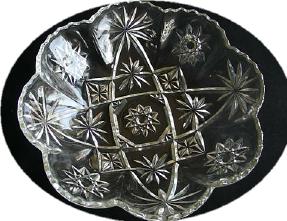National Depression Glass Association
Preserving America's Glass Manufacturing Heritage
Anchor Hocking's Early American Prescut
by Cathy Linehan, Tracy, CA
The Early American Prescut (EAPC) glassware line by Anchor Hocking is enjoying wide-spread popularity. There are many serious collectors, many of whom began this love of EAPC long before it was a popular thing to do. As one of these long-time EAPC collectors, I agreed to share some of the things I have learned and documented.
With this article, the focus will be EAPC pieces and current
price variances. Later articles will feature some interesting
historical and research facts that I have assembled. Other research
is in progress with a number of collectors co-operating with Dr.
 Leonette Walls. Facts from this group effort will be shared in
future issues.
Leonette Walls. Facts from this group effort will be shared in
future issues.
One of the basics of EAPC is being aware of what is easy and common and the hard-to-find Items. Also, be aware of items still in production. These pieces should not command premium prices, by any means!
A fellow EAPC collector friend of mine, Cheryl Briggs, reports that "EAPC is the last great collectible glass, but the prices are sky rocketing." Prices on EAPC are dependent to a great degree on what part of the country you are in and how plentiful that piece is in your neck of the woods. Pieces seem to have been distributed regionally -- some pieces are more prevalent in the south, others out west. One collector in Connecticut complains of being unable to find a cruet while I find one almost every weekend.
The more mundane pieces command a lower price. Among commonly seen items are: Creamers, punch bowls and cups, 10" tabbed handled relish dishes, gondolas, three-toed bowls, butter dishes, 10¾" salad bowl, and both sized candy dishes. Observe what items are commonly seen in your area before paying premium prices.
Hard to find items in most areas of the country include: the square pitcher, tea glasses, four and five part trays, cake plates, oil lamp, electric lamps made from the 8" vase (sold through Fingerhut, where I bought mine in 1996), lazy susans, small shakers and colored pieces. In general, I advise collectors to buy hard pieces when seen. You may regret passing one by later. Also, be careful about passing on favorite items; you may not see one again.
Current items for sale according to a report include 8½" vase and the 9" thick neck bud vase. Bar code tags on the bottom of each read "Anchor Hocking Glass, Made in USA." A report of the creamer being sold at a store chain in California states that an Anchor Hocking label was on the bottom. With those pieces still available for sale, don't pay antique shop prices.
Also, be aware that imported items also exist. Many of them bear the mark, "Italy," on the product.
As to what pieces were made, only time will tell. Discussion of available information on EAPC will be presented in a later article. Reports of colored pieces continue with verification of origin by labels and photographs. These are being added to the database created by Dr. Walls.
A side collection for many EAPC lovers are the after-market items that utilized EAPC. identifying the companies creating these composite items is another area being researched.
Early American Prescut glassware has a fairly long and large numbered run. Many of us have been loving this pattern for a long time and continue to collect it. Also, many new collectors are joining this "hot" collectible. Reports of new pieces will be greatly appreciated as we work toward an extensive EAPC listing.
Webmaster's Note: This article was taken from the publication "Glass and More, May 1998" with permission from the publisher, Dr. Leonette Walls.